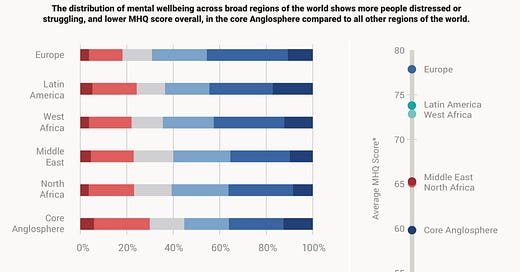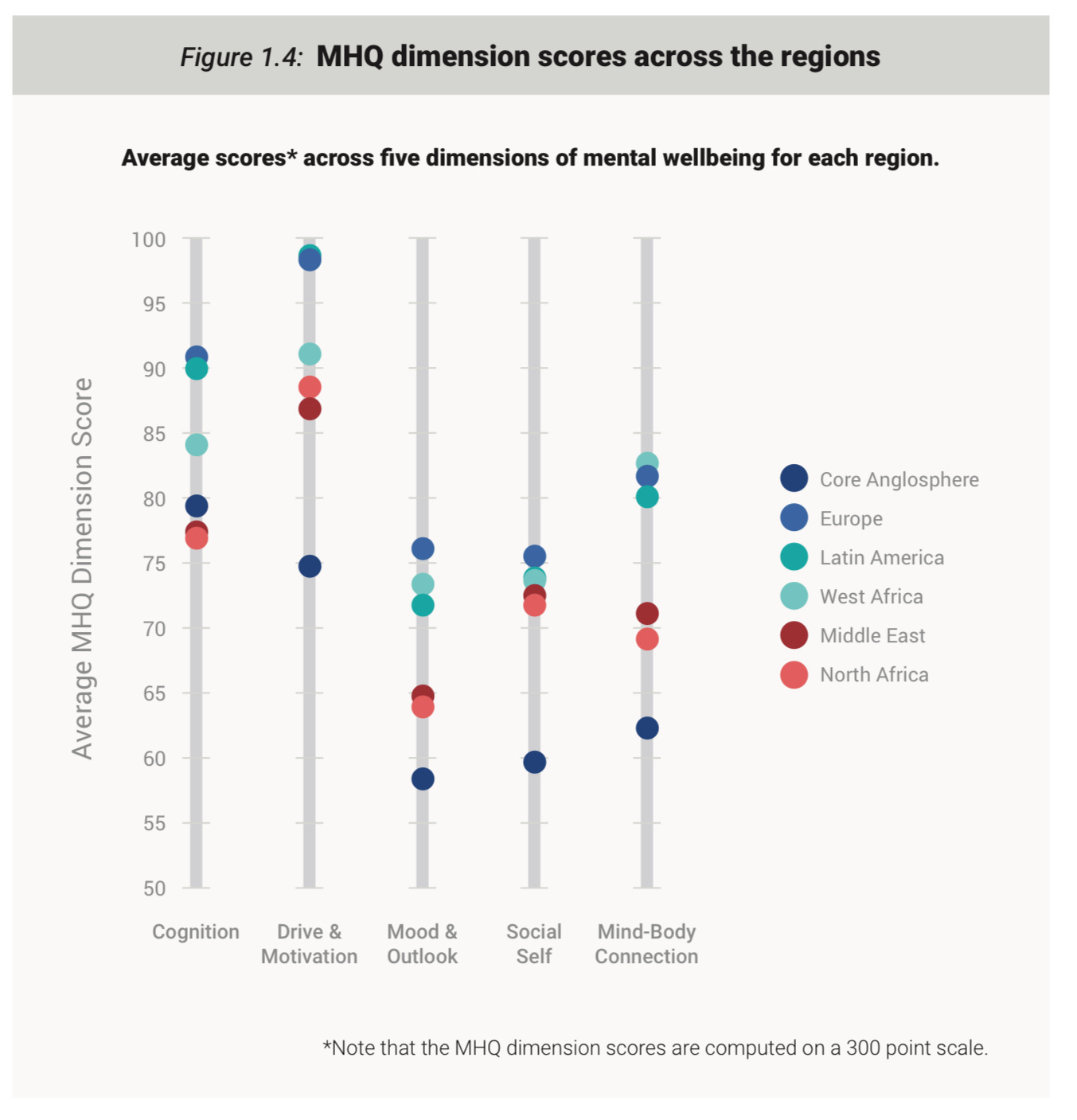26 April 2022. Mental Health | Fungi again
The kids aren’t alright. // The ever more mysterious world of fungi.
Welcome to Just Two Things, which I try to publish daily, five days a week. Some links may also appear on my blog from time to time. Links to the main articles are in cross-heads as well as the story. Recent editions are archived and searchable on Wordpress.
1: The kids aren’t alright
I hadn’t seen the Mental Health State of the World report until until it popped up in one of my feeds, but it’s now in its second year. The basics: an annual survey of mental health by Sapiens Labs, based on a model of wellbeing, which in 2021 involved surveying more than 220,000 people in 34 countries.
So a substantial piece of research, in other words. It says it is “the largest and most comprehensive study of global mental wellbeing currently in progress”, and that sounds like a believable claim. One caveat: most of the participants were recruited via Google or Facebook ads. They may not be completely representative, although you can do quite a lot of weighting with those kinds of response numbers, and they specifically exclude countries with lower internet numbers when testing some country hypotheses.
The two biggest headlines:
- 'an alarming plummet in mental wellbeing across successively younger generations is prevalent across every single country population that we sampled’
- 'mental wellbeing was poorest overall in English-speaking countries and highest in Latin American and European countries’.
Incidentally, although outcomes for women globally we slightly worse than men, the gap was modest—a couple of percentage points. MHQ, on the other hand, does correlate well with education levels.
More on all of that in a moment, but let me just mention their model first:
This project utilizes the Mental Health Quotient, or MHQ (Newson and Thiagarajan, 2020; Newson et al., 2022), delivered as an open online anonymous survey that takes approximately 15 minutes to complete and returns overall wellbeing scores as well as a comprehensive report with tailored self-care and help- seeking recommendations via email.
It generates a 300 point scale, which runs from -100 to +200 and generates six categories. The zero point on the scale, one third of the way along, represents the boundary between ‘struggling’ (below) and ‘enduring’ (above).
(Source: Mental State of the World 2021. Sapiens Labs)
It also assesses mental health outcomes across five functional dimensions: “Mood & Outlook, Social Self, Drive & Motivation, Mind-Body Connection, and Cognition.”
When you look across these dimensions it turns out that ‘the Anglosphere’ performs worst across almost all of them.
(Source: Mental State of the World 2021. Sapiens Labs)
The MHQ data by country does need some explanation. Venezuala is highest, for example, and in general Latin American countries perform well. The report reviews some hypotheses, looking across economic and demographic factors as well, and found, broadly, that cultural and attitudinal factors offered the strongest explanation. They used other social values metrics as a benchmark:
(W)e looked at correlations between MHQ scores and country-level cultural indicators of the Globe Project (House et al., 2004) as well as those compiled by Geert Hofstede at Maastricht University (Hofstede, 2013). Surprisingly, several indicators of culture had exceptionally strong correlations with mental wellbeing scores of countries. At the top of the list was the Globe Project’s indicator of Performance Orientation (House et al., 2004), a measure of how much rewards and recognition are based on work performance. Of all indicators examined, this was the most significantly negatively correlated to MHQ scores overall, all MHQ dimensional scores, and for all age and gender groups.
At the positive end of the cultural scale:
the indicators of Power Distance (GH), Uncertainty Avoidance (GH) and In-group or Family Collectivism (Globe Project) were positively correlated with mental wellbeing... A high Power Distance refers to cultures where there is a high acceptance of an unequal, hierarchical distribution of power, where people understand "their place" in the system. Similarly high Uncertainty Avoidance refers to the degree to which a society relies on social norms and rules to alleviate unpredictability, and in particular, social unpredictability. Finally, In-group or Family Collectivism refers to the degree to which societies express pride, loyalty and cohesion within their family groups.
The finding on the mental wellbeing of young people is perhaps more concerning, especially since it seems to have changed relatively quickly. The youngest cohort had the worst scores across all regions:
(Source: Mental State of the World 2021. Sapiens Labs)
This didn’t used to be the case:
In patterns of wellbeing observed prior to 2010, young people typically had the greatest happiness and wellbeing. In the United States wellbeing followed a U-shaped curve where younger and older adults fared best with a dip among the middle age groups (Stone et al., 2010). In Latin America on the other hand, wellbeing was highest among young adults, declining steadily with older age groups (Steptoe et al., 2015).
Later in the report, they suggest that this is connected to smartphone use. Not, in the conventional reading, that being online is bad for your mental health, but that the time spent online reduces conventional social interaction.
Vox, which covered the launch of the report, quoted Sapiens Lab founder Tara Thiagarajan as saying that one of the reasons why younger people might be experiencing poorer mental health outcomes is that they have less experience in solving social issues:
Thiagarajan believes the youngest generation has “arrived at age 18-24 and college with one-tenth of the expertise in solving social issues, living together, coexisting in productive ways without conflict. And I think a lot of the unrest and conflict may be quite related to that, because at age 18, now you have the same experience of interacting with people as a 7- or 8-year-old had in the past.”
I’m not persuaded by this—when I’ve seen this cohort operate they seem pretty socially skilled to me. And this explanation wouldn’t necessarily explain why their mental health numbers had slumped so much in a decade. In the short term, as they note elsewhere, the experience of lockdown seems to have had a serious effect. In the longer term, I’d be more persuaded by arguments about the ‘closing of their future’, looking at economic prospects, environmental outcomes, even the experience of living in ageing societies (true now everywhere outside of sub-Saharan Africa) where the experience of young people is less valued.
You can also take the MHQ for yourself, if you want to. But maybe wait until you’re feeling positive about the world. I don’t want to depress people.
2: The ever more mysterious world of fungi
I wrote last week about research that said that fungi may use a form of language to communicate. The current edition of Orion Magazine has a good piece on the symbiotic relationship between trees and fungi, from a new book.
Here’s an extract:
You could think of a fungal thread as a sort of inside-out digestive system. We break food down inside our guts. In fungi, this deconstruction of organic matter into the phosphorus, potassium, and nitrogen plants need to grow takes place on the outside of the fungal threads...
That’s only part of the story. In addition to breaking food down, the tips of fungal threads also contain acids, which interact with rocks to release traces of copper and zinc that the trees also need. And there’s more:
Beyond food and protection, fungi provide trees with one more essential service that helps connect the forest ecosystem. Trees communicate through their root systems and warn each other about such things as insect attacks or imminent drought. As trees can’t reach every corner of the forest with their roots, the interwoven fungal threads help relay the messages.
In exchange, the fungi will receive a third of the food it produces, mostly in the form of sugar. This is a highly symbiotic system.
Update:
I wrote yesterday morning about the impending impact of the EU’s Digital Markets Act on the way that big tech operates in Europe. By chance or synchronity, Charle Arthur’s The Overspill blog noted a piece in The Verge on its sister legislation, the Digital Service Act. Here’s a brief extract:
Early Saturday morning, after hours of negotiations, the bloc agreed on the broad terms of the Digital Services Act, or DSA, which will force tech companies to take greater responsibility for content that appears on their platforms. New obligations include removing illegal content and goods more quickly, explaining to users and researchers how their algorithms work, and taking stricter action on the spread of misinformation. Companies face fines of up to 6 percent of their annual turnover for noncompliance.
The new rules will come into force 15 months after the Act is voted into law, or on 1st January 2024, whichever is later.
j2t#304
If you are enjoying Just Two Things, please do send it on to a friend or colleague.






